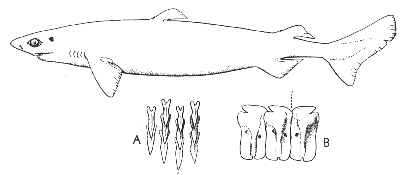Portuguese shark Centroscymnus coelolepis Bocage and Brito Capello 1864
[Bigelow and Schroeder, 1948, p. 494.]
[Garman, 1913, pl. 14, figs. 5-8.]

Figure 20.—Portuguese shark (Centroscymnus coelolepis), female about 421/2 inches long, off Banquereau Bank. A, upper teeth, and B, lower teeth from center of mouth, about 3.4 times natural size. From Bigelow and Schroeder. Drawings by E. N. Fischer.
Description—
This shark can be identified easily by the fact that while its general appearance (especially the absence of anal fin, the situation of its pelvics far back under the second dorsal, and its rather stout form and blunt snout) might lead a hasty observer to think he had caught a small Greenland shark; more careful examination, by touch if not by eye, would reveal a short spine close in front of each dorsal fin. The first dorsal fin is smaller than in any of our sharks except in the "Greenland," (p. 53), and in Dalatias licha (p. 55), the second dorsal is a little larger than the first, and the pelvics are larger than either of the dorsals. The tail is noticeably short and broad and the rear edge of its upper lobe is notched. The teeth are different in the two jaws; narrow, pointed, and of the seizing type in the upper; broader, oblong, with a notch on the outer side near the tip, and forming a continuous cutting edge in the lower. The dermal denticles are flat, scale-like, closely overlapping, and clothe the entire trunk.
Color—
Dark chocolate brown, belly as well as back and fins.
[page 53]Size—
Adults measure from 3 to 31/2 feet long, as they are caught. Garman records one 44 inches long taken off the coast of New England. About 9 inches is the smallest recorded.[39]
Habits—
Little is known of its habits beyond the fact that it is a deep-water species, and that it was caught regularly by Portuguese fishermen with hand lines, a fishery that Wright[40] described as follows:
Some 600 fathoms of rope were let out, the first 30 or 40 fathoms of which had fastened to it at intervals of a fathom a series of small ropes, on each of which was a large hook baited with a codling. This fishing tackle remained below for about two hours, when they commenced to haul it in. When it arrived at the last few fathoms, they pulled in, one after another, five or six specimens from 3 to 4 feet long. The species was the Centroscymnus coelolepis Bocage and Capello. These sharks, as they were hauled into the boat, fell down into it like so many dead pigs.
Thirteen to 16 young have been found in females caught off Portugal.
General range—
This deep-water shark, originally discovered off Portugal, has since been taken at various other eastern Atlantic localities.[41] Definite records of it for the western Atlantic are from the slopes of the Nova Scotian Banks and of Georges, at depths of 180 to 250 fathoms, perhaps 15 to 20 specimens in all. But Goode and Bean's[42] old characterization of them as abundant on the Banks at 200 fathoms and deeper presents its local status more correctly, for fishermen long lining for halibut often caught one or two a trip in the deeper gullies between the offshore Banks.
[39] A male 228 mm. long, examined by us, in the U. S. National Museum, from the continental edge south of Nantucket.
[40] Ann. Mag. Nat. Hist., Ser. 4, vol. 2, 1868, p. 426.
[41] Iceland; Faroe Bank; Madeira; Azores; Morocco; Cape Verde I.: For key to other species of the genus, see Bigelow and Schroeder, Fishes Western North Atlantic, P. 1, 1948, p. 494.
[42] Smithsonian Contrib. Knowledge, vol. 30, 1895, p. 14.